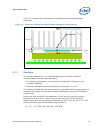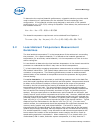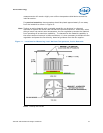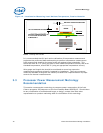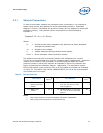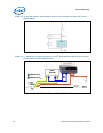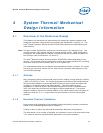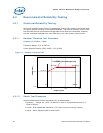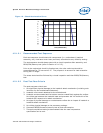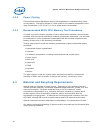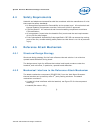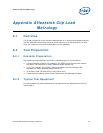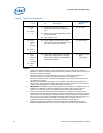
System Thermal/Mechanical Design Information
Thermal and Mechanical Design Guidelines 37
4 System Thermal/Mechanical
Design Information
4.1 Overview of the Reference Design
This chapter will document the requirements for designing a passive heatsink that
meets the maximum usage power consumption that mentioned in Section
2.4. The
Intel
®
Boxed Processor thermal solution E21953-001 satisfies the specified thermal
requirements.
Note: The part number E21953-001 provided in this document is for reference only. The
revision number -001 may be subject to change without notice. OEMs and System
Integrators are responsible for thermal, mechanical and environmental validation of
this solution (refer to Sections 4.1.2 and 4.2).
The Intel
®
Boxed Processor thermal solution E21953-001 takes advantage of cost
savings. The thermal solution supports the unique and smaller desktop PCs including
small and ultra small form factors, down to a 5L system size.
The motherboard keep-out and height recommendations shown in Section
2.1 remain
the same for a thermal solution for the Intel Celeron processor 200 sequence in the
micro-FCBGA package.
4.1.1 Altitude
Many companies design products that must function reliably at high altitude, typically
1,500 m [5,000 ft] or more. Air-cooled temperature calculations and measurements
at the test site elevation must be adjusted to take into account altitude effects like
variation in air density and overall heat capacity. This often leads to some
degradation in thermal solution performance compared to what is obtained at sea
level, with lower fan performance and higher surface temperatures. The system
designer needs to account for altitude effects in the overall system thermal design to
make sure that the T
S-TOP-MAX
requirement for the processor is met at the targeted
altitude.
4.1.2 Heatsink Thermal Validation
Intel recommends evaluation of the heatsink within the specific boundary conditions
based on the methodology described in Chapter
3.
Testing is done on bench top test boards at ambient laboratory temperature.
The test results, for a number of samples, are reported in terms of a worst-case mean
+ 3σ value for thermal characterization parameter using real processors.



